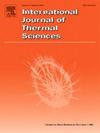Influences of wall materials on flow and thermal performance of S-CO2 at high pressure and heat flux
IF 4.9
2区 工程技术
Q1 ENGINEERING, MECHANICAL
International Journal of Thermal Sciences
Pub Date : 2025-03-26
DOI:10.1016/j.ijthermalsci.2025.109899
引用次数: 0
Abstract
Since supercritical carbon dioxide (S-CO2) systems usually have to work at both high temperature, high pressure and high heat flux, selecting appropriate solid materials is of great important to their system safety. In this study, the thermofluidic characteristics of supercritical carbon dioxide (S-CO2) in a horizontal rectangular channel have been investigated under high pressure and one-side-wall heated with high heat flux. Four different solid wall materials (253 MA, Inconel 617, Haynes 230 and Haynes 233) and three different heat flux values (1.5 MW/m2, 2.0 MW/m2 and 2.5 MW/m2) are selected for analyzing the impacts of wall material and heat flux boundary conditions. The results showed that the maximum wall temperature difference of all four wall materials can generally exceed 100 K under the minimum heat flux, and can reach 500 K for Haynes 233 at the heat flux of 2.5 MW/m2. Considering the maximum allowable stress and creep characteristics, Inconel 617 has more obvious advantages as a solid material at the heat flux below 2 MW/m2, while Haynes 230 is a better choice at the heat flux beyond 2 MW/m2 because of the stronger mechanical properties. By exploring the effect of inlet temperature, it is found that the inlet temperature close to the pseudo-critical temperature is conducive to flow and heat transfer. Taking the effect of buoyancy into account, it is shown that the temperature of the heating surface is decreased, the deterioration of heat transfer is weakened and occurs early, and the difference on the cross sections of the wall temperature decreases.
墙体材料对高压和高热流密度下S-CO2流动和热性能的影响
超临界二氧化碳(S-CO2)系统通常需要在高温、高压和高热流密度下工作,因此选择合适的固体材料对其系统安全至关重要。本文研究了超临界二氧化碳(S-CO2)在高压和高热流密度的单壁加热条件下在水平矩形通道中的热流特性。选择4种不同的固体墙体材料(253 MA、Inconel 617、Haynes 230和Haynes 233)和3种不同的热流密度值(1.5 MW/m2、2.0 MW/m2和2.5 MW/m2),分析墙体材料和热流密度边界条件的影响。结果表明,在最小热流密度下,四种墙体材料的最大壁温差均可超过100 K, Haynes 233在热流密度为2.5 MW/m2时,墙体温差可达500 K。考虑最大许用应力和蠕变特性,Inconel 617在热流密度低于2 MW/m2时作为固体材料优势更明显,而Haynes 230在热流密度大于2 MW/m2时力学性能更强,是较好的选择。通过对进口温度影响的探讨,发现接近拟临界温度的进口温度有利于流动和换热。考虑浮力的影响,受热面温度降低,换热恶化减弱且发生早,壁面温度截面差减小。
本文章由计算机程序翻译,如有差异,请以英文原文为准。
求助全文
约1分钟内获得全文
求助全文
来源期刊

International Journal of Thermal Sciences
工程技术-工程:机械
CiteScore
8.10
自引率
11.10%
发文量
531
审稿时长
55 days
期刊介绍:
The International Journal of Thermal Sciences is a journal devoted to the publication of fundamental studies on the physics of transfer processes in general, with an emphasis on thermal aspects and also applied research on various processes, energy systems and the environment. Articles are published in English and French, and are subject to peer review.
The fundamental subjects considered within the scope of the journal are:
* Heat and relevant mass transfer at all scales (nano, micro and macro) and in all types of material (heterogeneous, composites, biological,...) and fluid flow
* Forced, natural or mixed convection in reactive or non-reactive media
* Single or multi–phase fluid flow with or without phase change
* Near–and far–field radiative heat transfer
* Combined modes of heat transfer in complex systems (for example, plasmas, biological, geological,...)
* Multiscale modelling
The applied research topics include:
* Heat exchangers, heat pipes, cooling processes
* Transport phenomena taking place in industrial processes (chemical, food and agricultural, metallurgical, space and aeronautical, automobile industries)
* Nano–and micro–technology for energy, space, biosystems and devices
* Heat transport analysis in advanced systems
* Impact of energy–related processes on environment, and emerging energy systems
The study of thermophysical properties of materials and fluids, thermal measurement techniques, inverse methods, and the developments of experimental methods are within the scope of the International Journal of Thermal Sciences which also covers the modelling, and numerical methods applied to thermal transfer.
 求助内容:
求助内容: 应助结果提醒方式:
应助结果提醒方式:


